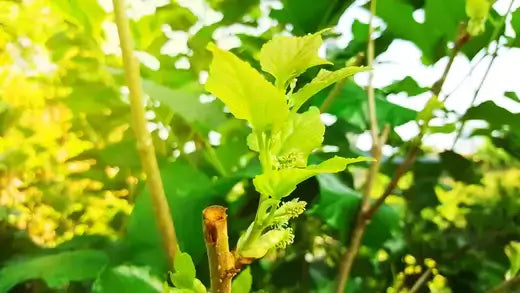The fruitless 'mulberry was not fruitless originally. It is a product of much time, energy, knowledge, and hard work.
The tree from which it was derived was not even a native to our country. Our native mulberry is the red mulberry,
Morus rubra is found in the eastern part of the country, from Massachusetts to Kansas and down to the Gulf coast.
The predecessor to the fruitless mulberry was the- white mulberry, Morus alba. It is native to eastern and central China and has been naturalized in Europe for centuries. This tree was introduced into America in early colonial times for silkworm culture. The white mulberry leaves are the main diet for silkworms. It was hoped that the silk industry would become prosperous in this country, but it never did, so the idea was abandoned. Even though the silk industry didn't make it here, the trees flourished. They have overrun the red mulberry in its native environment.
The white mulberry became a fast-growing shade-- a tree that many people liked for its fruit and dense shade on hot days. There grew an objection to the fruit, which could become quite messy if it was not picked and used. Work was begun on creating a tree that would provide quick shade without the mess of the fruit. With time and work, it was; accomplished.
The fruitless mulberry is a deciduous tree, growing to 35 feet high with a wider spread. The leaves vary in form but are usually lobed, sort of like a maple leaf. They are relatively thin, glossy, and light green. In autumn, they turn yellow and fall, making a lot of work raking and disposing of them, but they are an excellent addition to the compost pile. In spring, they will flower and produce vast amounts of pollen. If you have allergies, beware! The flowers 'fall ' and create a mess but don't produce fruit. The branches proliferate; a new shoot can become 8 to 10 feet long in one season but very thin.
Make sure your tree is planted in full sun with lots of space to spread out. A well-drained deep loam is ideal; however, these trees will do well even in dense clay. As a lawn tree, they do great, sharing the water and fertilizer used on the grass. They do have heavy surface roots, though. Prune the tree every year to keep them in bounds. If you don't like the look of a bare trunk with a bunch of rough knobs at the top, you can selectively prune the branches, removing some and thinning and shortening others to keep a healthy-looking specimen. These trees don't usually have many pest problems:
Acquaintances of mine have a couple of these trees; I can't recall them that mentioned they had a pest problem.
They are lovely shade- trees and, if so inclined, great for climbing. In autumn, you burn many calories by raking in the abundance of leaves, an excellent benefit for your compost pile.
Source of Information on the Fruitless Mulberry Tree
https://www.tnnursery.net
